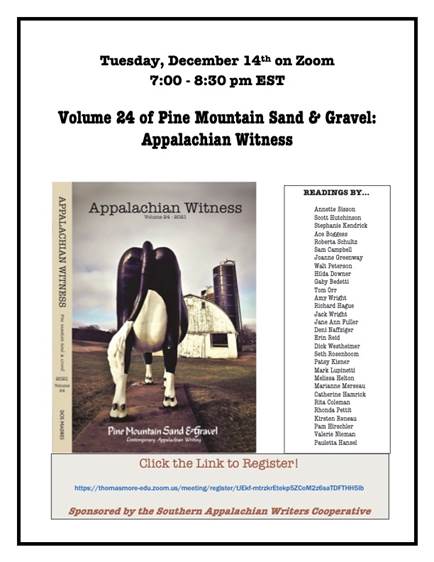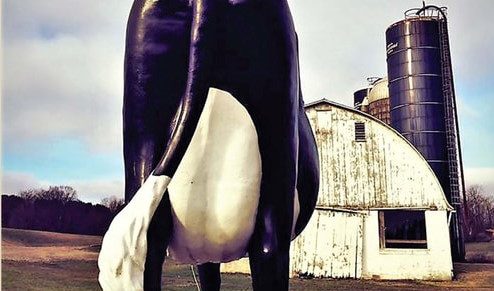The most recent issue of Pine Mountain Sand & Gravel is out. The publication of the Southern Appalachian Writers Cooperative (SAWC) has been a leading medium for Appalachian writers, poets, and artists since the mid-1980s. SAWC was founded to foster community and activism among and encourage publication of Appalachia’s writers. and as part of its mission, sponsors this annual themed literary journal focusing on writers from the Appalachian Mountains. The new issue of PMS&G, subtitled “Appalachian Witness,” published in cooperation with Dos Madres Press, includes works by members of the Urban Appalachian Community Coalition, as well as selections from new writers and artists alongside established voices. The “Appalachian Witness” edition of PMS&G launched virtually in November. A second reading from the journal will be held via Zoom on Tuesday, December 14 at 7 pm.

The notion of being a witness to and/or for Appalachia—in the broadest sense of how we may interpret both terms—seems urgent these days. As everything that is, was, or ever can be appears to be swallowed and reproduced as a genuine copy, the responsibility of eye-witness testimony seems imperative. Thus, an issue that takes on the idea of being a witness, of authentic testimony, and the responsibility we have as witnesses becomes increasingly urgent. The works in this issue of Pine Mountain Sand & Gravel are tied by the common theme of telling our story, of providing a window into lived experiences and the Appalachian life that grounds these experiences.
You can begin most anywhere but Ace Boggess is one who throws us into the confusion of contemporary life in his poem “One Foot Dancing.” Reading this poem, I can hear the voice of so many older people who said things like “When I look back at those actions/ I’ve read will take ten years off my life–/ I should’ve died yesterday,/ should’ve died a half a century before I was born.” The absurdity of the official message is offset by the reality of lived life. This is the voice of a witness for the living who testifies against the dead voice of the electronic machine that tells us how it is no matter what it is that we are living. The speaker in the poem finishes by telling us: “I’m tired, crackling ankles, knees, & back,” but that he must “maintain one foot dancing though it hurts.” This is no platitude of superficial optimism; it is what is left in life when one is actually living life.
We could also examine Gaby Bedetti’s photograph titled “Pigeon on a Cross.” It is a stark black and white image which emerges as just shades of gray. The cross emerges from the bottom of the frame; it is abrupt, and the cross itself appears to be made from concrete. The pigeon sits on top facing away from the camera. This image does not evoke old-timey ideas of religion and salvation. It has more in common with images of industrial landscapes and lifeless zones of the urban landscape. The sky itself is gray. It would be a disservice to the photograph (and the photographer) to provide a meaning for something so haunting and ambiguous. Suffice that Bedetti’s image does not rely on our conventional associations with the image of the cross. Here we are invited to witness for ourselves something that does not fall into ready-made categories of experience.
We should also consider Core member Pauletta Hansel’s “Safe as Sand” which offers a testimonial to the coal ash spill in Tennessee in which people were criminally exposed to the carcinogenic toxins of coal ash. The poem lures us in quickly with the language of everyday conversation: “Was it dusty?/ Lord yes./ We’d drive our trucks through glittering clouds.” But the tone and nature of the poem shift just as fast as we learn that workers were told to not wear masks because “it would look bad.” With this, countless people were exposed and made terminally ill. In Pauletta Hansel’s rendering, people were told “no need to worry; you could eat a pound a day,/ they told us. No masks either./ It would look bad for tourists headed out to the lake.” This is not bitter irony. This is the voice of a witness to the stark facts of the criminal negligence of those who “tested the fish for arsenic. Not us.” Pauletta Hansel’s poem documents just one of the more recent corporate crimes committed in Appalachia.
If it seems like I have focused on the bad news it is because the past year or two have been marked by some very real struggles. We have been through social upheaval, fractures in society along lines of race, gender, sexuality, religion—you name it. The last two years have been tough on everyone, and Appalachians, urban and rural, have borne their share of the burden—maybe more than their share in some cases, and Pine Mountain Sand & Gravel has provided a medium through which the writers, poets, and artists who claim Appalachia as heart and home are giving voice to these difficulties in the most compelling ways.
Perhaps one of the most standout images of the past year and half is that of all of us meeting though digital space. Zoom is how we exist now. It is our medium by which we remain separated while together. While we do the best we can, and we try hard to accept this substitute for living interaction, it remains a mode of isolation and separation. Sam Campbell captures this in his poem “Self-Portrait in a Zoom Call.” Just as our posts on social media disappear into the infinite anonymity of other voices and thus leave is speaking to ourselves, so the array of faces on our screen on a Zoom meeting ultimately leave us talking to ourselves. Campbell captures this beautifully: “I never speak to others now; I talk only to myself. My face stares back at me as I converse with my own greens. Watch the way my lips curve around words, carefully carve out an appropriate smile, positioned just so—.” Zoom, it would appear, can bring us together. Even as it further solidifies our separation. We cannot leave ourselves in the company of others while the image of ourselves stares back at us from a screen.
Nonetheless, if you would like to hear and see the writers of Pine Mountain Sand & Gravel: Appalachian Witness anytime soon, Zoom is how to do it! You may attend a reading from the Appalachian Witness edition of PMS&G on Tuesday, December 14 at 7 pm by registering at https://thomasmore-edu.zoom.us/meeting/register/tJEkf-mtrzkrEtekp5ZCoM2z6saTDFTHH5Ib. Order information can be found at http://www.sawconline.net/pine-mountain-sand–gravel-journal.html.
Mike Templeton is a writer, independent scholar, barista, cook, guitar player, and accidental jack-of-all-trades. Check out his profile in UACC’s new Cultural Directory. He lives in downtown Cincinnati with his wife who is a talented photographer. They spend their free time walking around the city snapping photos. She looks up at that the grandeur of the city, while Mike always seems to be staring at the ground.

